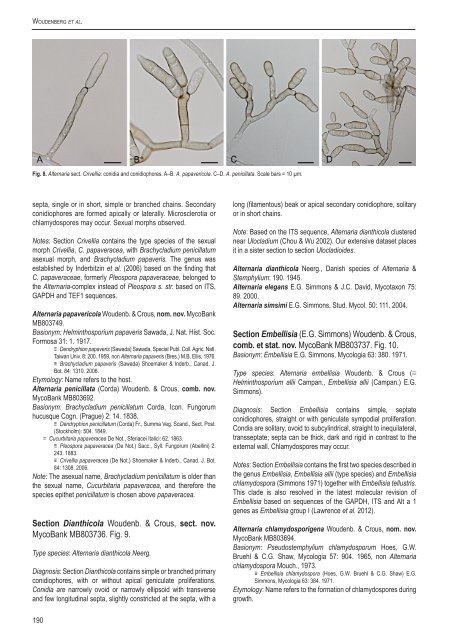Alternaria redefined - CBS - KNAW
Alternaria redefined - CBS - KNAW
Alternaria redefined - CBS - KNAW
Create successful ePaper yourself
Turn your PDF publications into a flip-book with our unique Google optimized e-Paper software.
Woudenberg et al.<br />
Fig. 8. <strong>Alternaria</strong> sect. Crivellia: conidia and conidiophores. A–B. A. papavericola. C–D. A. penicillata. Scale bars = 10 µm.<br />
septa, single or in short, simple or branched chains. Secondary<br />
conidiophores are formed apically or laterally. Microsclerotia or<br />
chlamydospores may occur. Sexual morphs observed.<br />
Notes: Section Crivellia contains the type species of the sexual<br />
morph Crivellia, C. papaveracea, with Brachycladium penicillatum<br />
asexual morph, and Brachycladium papaveris. The genus was<br />
established by Inderbitzin et al. (2006) based on the finding that<br />
C. papaveraceae, formerly Pleospora papaveraceae, belonged to<br />
the <strong>Alternaria</strong>-complex instead of Pleospora s. str. based on ITS,<br />
GAPDH and TEF1 sequences.<br />
<strong>Alternaria</strong> papavericola Woudenb. & Crous, nom. nov. MycoBank<br />
MB803749.<br />
Basionym: Helminthosporium papaveris Sawada, J. Nat. Hist. Soc.<br />
Formosa 31: 1. 1917.<br />
≡ Dendryphion papaveris (Sawada) Sawada, Special Publ. Coll. Agric. Natl.<br />
Taiwan Univ. 8: 200. 1959, non <strong>Alternaria</strong> papaveris (Bres.) M.B. Ellis, 1976.<br />
≡ Brachycladium papaveris (Sawada) Shoemaker & Inderb., Canad. J.<br />
Bot. 84: 1310. 2006.<br />
Etymology: Name refers to the host.<br />
<strong>Alternaria</strong> penicillata (Corda) Woudenb. & Crous, comb. nov.<br />
MycoBank MB803692.<br />
Basionym: Brachycladium penicillatum Corda, Icon. Fungorum<br />
hucusque Cogn. (Prague) 2: 14. 1838.<br />
≡ Dendryphion penicillatum (Corda) Fr., Summa Veg. Scand., Sect. Post.<br />
(Stockholm): 504. 1849.<br />
= Cucurbitaria papaveracea De Not., Sferiacei Italici: 62. 1863.<br />
≡ Pleospora papaveracea (De Not.) Sacc., Syll. Fungorum (Abellini) 2:<br />
243. 1883.<br />
≡ Crivellia papaveracea (De Not.) Shoemaker & Inderb., Canad. J. Bot.<br />
84: 1308. 2006.<br />
Note: The asexual name, Brachycladium penicillatum is older than<br />
the sexual name, Cucurbitaria papaveracea, and therefore the<br />
species epithet penicillatum is chosen above papaveracea.<br />
Section Dianthicola Woudenb. & Crous, sect. nov.<br />
MycoBank MB803736. Fig. 9.<br />
Type species: <strong>Alternaria</strong> dianthicola Neerg.<br />
Diagnosis: Section Dianthicola contains simple or branched primary<br />
conidiophores, with or without apical geniculate proliferations.<br />
Conidia are narrowly ovoid or narrowly ellipsoid with transverse<br />
and few longitudinal septa, slightly constricted at the septa, with a<br />
long (filamentous) beak or apical secondary conidiophore, solitary<br />
or in short chains.<br />
Note: Based on the ITS sequence, <strong>Alternaria</strong> dianthicola clustered<br />
near Ulocladium (Chou & Wu 2002). Our extensive dataset places<br />
it in a sister section to section Ulocladioides.<br />
<strong>Alternaria</strong> dianthicola Neerg., Danish species of <strong>Alternaria</strong> &<br />
Stemphylium: 190. 1945.<br />
<strong>Alternaria</strong> elegans E.G. Simmons & J.C. David, Mycotaxon 75:<br />
89. 2000.<br />
<strong>Alternaria</strong> simsimi E.G. Simmons, Stud. Mycol. 50: 111. 2004.<br />
Section Embellisia (E.G. Simmons) Woudenb. & Crous,<br />
comb. et stat. nov. MycoBank MB803737. Fig. 10.<br />
Basionym: Embellisia E.G. Simmons, Mycologia 63: 380. 1971.<br />
Type species: <strong>Alternaria</strong> embellisia Woudenb. & Crous (≡<br />
Helminthosporium allii Campan., Embellisia allii (Campan.) E.G.<br />
Simmons).<br />
Diagnosis: Section Embellisia contains simple, septate<br />
conidiophores, straight or with geniculate sympodial proliferation.<br />
Condia are solitary, ovoid to subcylindrical, straight to inequilateral,<br />
transseptate; septa can be thick, dark and rigid in contrast to the<br />
external wall. Chlamydospores may occur.<br />
Notes: Section Embellisia contains the first two species described in<br />
the genus Embellisia, Embellisia allii (type species) and Embellisia<br />
chlamydospora (Simmons 1971) together with Embellisia tellustris.<br />
This clade is also resolved in the latest molecular revision of<br />
Embellisia based on sequences of the GAPDH, ITS and Alt a 1<br />
genes as Embellisia group I (Lawrence et al. 2012).<br />
<strong>Alternaria</strong> chlamydosporigena Woudenb. & Crous, nom. nov.<br />
MycoBank MB803694.<br />
Basionym: Pseudostemphylium chlamydosporum Hoes, G.W.<br />
Bruehl & C.G. Shaw, Mycologia 57: 904. 1965, non <strong>Alternaria</strong><br />
chlamydospora Mouch., 1973.<br />
≡ Embellisia chlamydospora (Hoes, G.W. Bruehl & C.G. Shaw) E.G.<br />
Simmons, Mycologia 63: 384. 1971.<br />
Etymology: Name refers to the formation of chlamydospores during<br />
growth.<br />
190

















